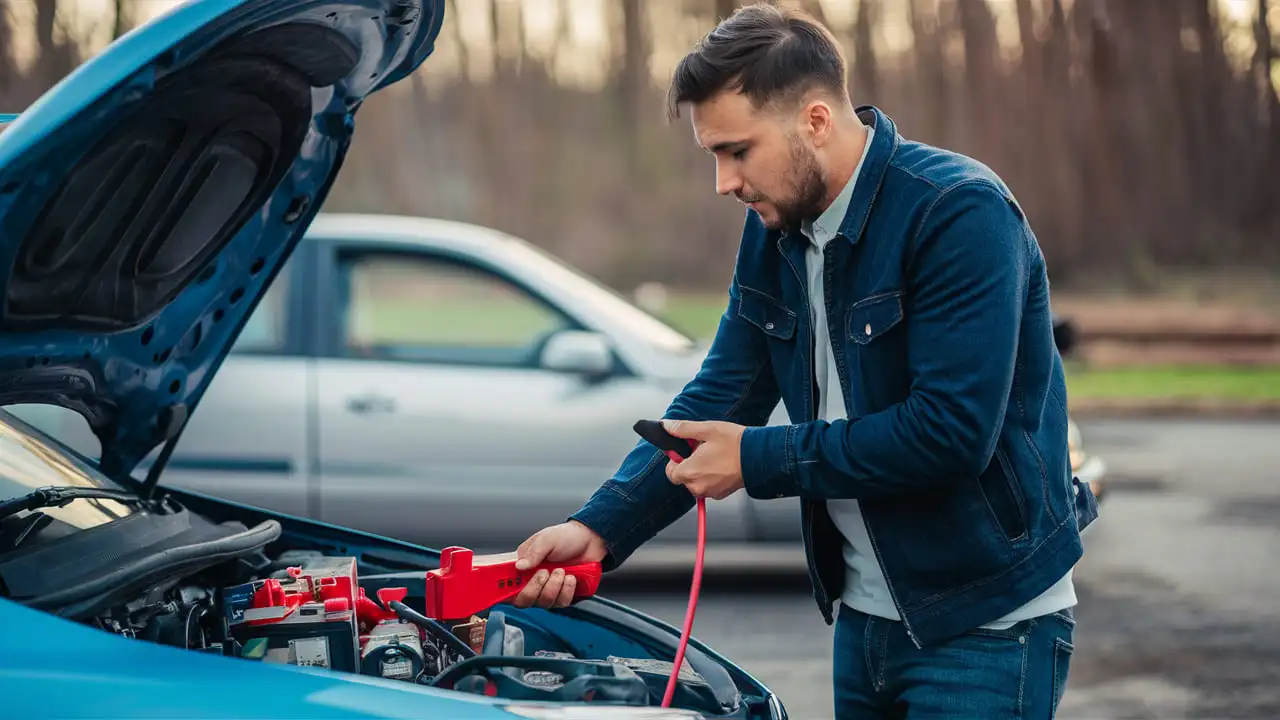 Date: June 21, 2024
Date: June 21, 2024
Imagine that you are about to start on your upcoming exciting road trip. You've planned, carefully packed your belongings, and hidden snacks, topped off your gas tank, and identified the best routes to reach your destination—all while taking in the beautiful surroundings. You won't notice you're stuck in traffic until you hear the dreaded "click" as soon as you insert your key in the ignition.
A dead car battery is common. However, If you know how to jump-start a car, the discomfort of a dead battery can be significantly reduced.
Relax! It doesn't have to take hours of effort and sparks to revive your battery. All you have to do is take these easy steps to recharge and resume your holiday.
Get Powered up With These Essentials
The jump-starting process requires you to have certain essentials before starting the procedures. This will ensure a smooth process of connecting cables and starting the vehicle.
Jumper cables: A convenient set of jumper cables has to be kept in your car at all times. They typically range in length from 10 to 20 feet. Longer connections provide a greater reach, but as the energy moves farther, you run the danger of losing power. Make sure the cables you utilize are free of corrosion, fraying, or rust.
A car with a functional battery: You'll need an alternate car to recharge yours unless you have a power box handy. It must, however, have the same voltage as the car being jumped. Most auto batteries have a voltage of 12.6 volts or higher. Before receiving or providing a jump, check your owner's manual if you drive a more unusual car, like an RV.
Rag or Paper Towel: If the terminals on your batteries are unclean, you can use a paper towel or rag. Wipe them clean before you jump to get the best possible leap.
Jumping a Dead Car Battery
If your battery runs out of power, all you need to jump-start your car is another car and the cords to connect them. In case you or someone else needs a jump start, it is wise to always have a set of cables in your car.
When both of these are ready to go, follow the below instructions to jump-start your car:
Bring The Engines Close
Bring the operational car engine close to your own first. It's acceptable to park your car facing your car or parallel to it, but ideally, the two engines should be no more than two feet apart.
Cut the Power:
After that, turn off the two cars.
Connect Positive to Positive:
To begin, attach the jumper cables' positive (often red) clamps to the positive terminals of your battery. Though they are commonly marked, these can be challenging to spot. Make sure you are connecting to the correct area of the battery by carefully examining it.
Connect Negative to Negative:
Join the jumper cable's negative (often black) clamps to the live battery's negative terminal. Place the negative terminal of your automobile on an unpainted metal surface.
Safety First:
Keep in mind that you should always connect the dead battery to the positive lines before attaching them to the batteries. There could be a risk to your safety if you inject energy into the cables before they are attached to your battery. It's crucial to seek professional assistance if you ever feel uncertain or frightened rather than jeopardize your security.
Start The Working Vehicle:
Turn on the functional car. Give the engine a little gas, and then let it run for a few minutes to allow your battery to fully charge.
Start Your Car
Make sure your car is still linked before you start it. Give it one more minute and try again if it doesn't start right away.
Disconnect the Cables:
Gently unplug the cables in the opposite order that they were installed in the cars. First disconnect the negative cable from your car, then the other car's negative cable, your car's positive cable, and lastly the other car's positive cable.
Remember that driving charges your battery. Consider driving the leisurely route to your destination after starting your car to give your battery more time to recharge. This first dead battery is an indication that you need to replace it, even if it leaps and recharges. As soon as possible, take your car to a nearby repair.
Additional Jump-Starting Options
There are two other ways to jump start your battery if the conventional method isn't successful for you:
Battery Back Jumping
Purchasing a battery jumper pack, which is a portable battery with wires that can jump-start your automobile, is an alternative to doing a standard jump. Please take care to carefully follow the instructions that come with this battery, since every gadget is built slightly differently.
Mechanic Valet and Pickup/Drop off:
Hiring professional assistance is the last resort. Roadside assistance from AAA is dependable and capable of locating you and changing your battery. You can contact a mechanic for pick-up and delivery services if you don't have a membership. These auto professionals may repair or maintain your battery and deliver your car when it's ready, even though it must be able to be driven.
Recharge With These Steps
Jump-starting a car can be simple with the right steps. Gather your materials, clear the area of small children, and clean dirty terminals. Disconnect any unused gadgets. Follow this guide to safely recharge your car battery.
- Prepare and get all the materials ready. Make sure all small children are out of the way, and clean off any dirty terminals. Disconnecting any unused gadgets from your car, such as a phone charger, is also a good idea.
- After the two cars are parked near to one another, put them in park or neutral and turn off their ignitions. Verify that the parking brake is applied.
- Connect one of the red cables to the dead battery's positive terminal. The terminal may have the letters "POS" or "+" to aid in identifying it.
- Connect the other red cable to the vehicle's positive terminal.
- Connect one of the black cables to the negative terminal of the working car's battery. It might have the label "-" or "NEG."
- The last black clip should be fastened to an unpainted metal area beneath your hood that is away from the battery. Sparking will be avoided by grounding the circuit in this way.
- Turn on the functional car and allow it to run for a short while. You might need to run the functional vehicle for a longer period of time if your battery is more "dead."
- Try to get your car started. Run the functional vehicle for a few more minutes if it doesn't start.
- Don't turn off your vehicle if it DOES start! The cables should be unplugged in the opposite order that they were installed (Black for a dead battery, Black for a good battery, Red for a good battery, Red for a dead battery).
- If you want to make sure your battery gets charged, drive for at least 15 to 30 minutes.
Car Still Won’t Start After a Jump?
If your car still doesn't start, there might be a problem other than a dead battery. Your car might need a thorough inspection of the interaction between your starter, alternator, and battery. Take your car for expert assistance.
Fasttrack Emarat has all the necessary parts to restart your car. You may visit our website for more information. Our dependable auto professionals are ready to serve you. Make an appointment with Fasttrack to get going right now!
